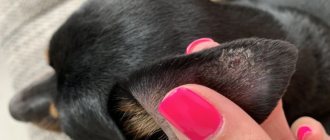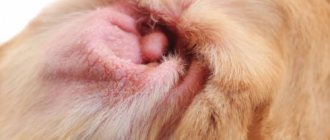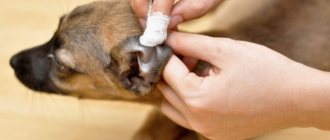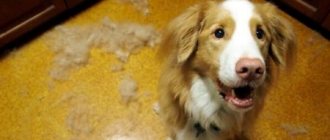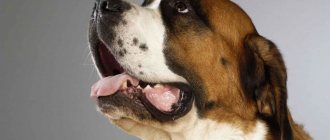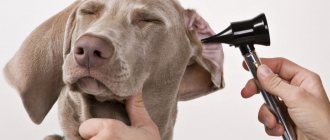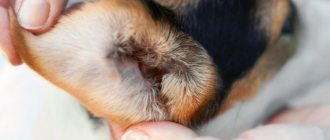An attentive, loving dog owner always notes any changes in the animal’s health.
It is important not to forget about preventive examinations in order to prevent the development of dangerous pathologies.
In some cases, the presence of a disease may be indicated by specific signs, one of which is an unpleasant odor from the ears.
Bacterial infections
The cause of an unpleasant odor coming from your pet's ears may be a bacterial infection. In addition to the unpleasant odor due to inflammation caused by bacteria, the animal is bothered by severe itching and there is a discharge of sulfur mixed with pathogens.
The danger of a bacterial infection is that it can quickly spread and affect deeper areas of the dog’s ear, causing dangerous complications.
Auricular hematoma
Hematoma of the auricle, otherwise called otohematoma, is an accumulation of fluid between the cartilage and skin of the ear. A hematoma occurs due to rupture of blood and/or lymphatic vessels, as a result the ear greatly increases in size.
Symptoms:
- Thickening or swelling of the ear, its drooping, tilting the dog’s head to the side.
— The disease is often accompanied by itching, which can provoke scratching and further trauma to the ear.
Treatment:
1. Apply a pressure bandage for 5-6 days, then open and remove dead tissue.
2. Large wounds are stitched.
3. After the operation, the ears are wrapped around the head and a bandage is applied. For better healing, the bandage is applied with ointments Levomekol, Methyluracil, Solcoseryl.
============================================================================================================================================================================================
Otitis
Inflammation in the auricle can have different origins.
Predisposing factors to the development of otitis and the appearance of an unpleasant odor from the ear canal are:
- congenital narrowing of the auditory canal or pronounced bending;
- excessive activity of glands secreting a special substance - sulfur;
- increased hairiness of the auricle, which leads to problems with the outflow of wax from the ears;
- the presence of systemic pathologies - allergic reaction, atopic dermatitis, seborrhea, insufficiency of thyroid hormone production.
In veterinary practice, otitis media is more often diagnosed in dog breeds with long ears, as well as in those that prefer to swim in bodies of water. Constant humidity in the ear canal and insufficient air microcirculation leads to increased activity of pathogenic microorganisms that provoke the development of inflammation.
Certain dog breeds have a natural predisposition to otitis media. Otitis is more often diagnosed in German Shepherds and Charles Spaniels due to a congenital feature - narrowing of the horizontal part of the auditory canal.
Otitis in a pet is a common problem for owners of dogs whose fur needs to be trimmed. Constant injury from plucking fur hairs provokes inflammation. Dogs with a weakened immune system are especially at risk of developing otitis media. It should be understood that increased vegetation in the ears is unacceptable. It is recommended not to pluck it, but to trim it, reducing the risk of microtrauma.
Ear pain - how to determine it
The inside of the animal's ear is red and much hotter than the rest of the body. The dog shakes its head, tilts it towards the diseased organ, complains and whines. May also scratch it constantly, sometimes even until it bleeds. On the side of the diseased organ, the muscles are tense and painful on palpation.
- Discharge comes out of the ears, sometimes colorless; in advanced cases, it thickens and turns into pus.
- The dog’s behavior has changed - it is restless, aggressive, or, conversely, indifferent to everything, its appetite is reduced or absent. She may also experience insomnia.
- In all these cases, you should not self-medicate, but urgently contact a veterinarian.
Foreign body in the ear
The appearance of an unpleasant odor from a dog's ear canal may indicate the presence of a foreign object in the ear. The auditory canal in dogs has a number of structural features. Not all owners are able to independently detect and then easily remove a foreign body from their pet’s ear.
In addition to the unpleasant odor, symptoms of a foreign object stuck in the ear canal include:
- shaking of head and ears;
- tilting the head to the side;
- animal anxiety;
- whining and attempts to scratch the ear on hard surfaces.
When the first characteristic signs appear, it is recommended to immediately seek help from a veterinarian before the situation worsens. Various twigs, plant seeds, and cotton wool particles can get stuck in the ear canal if the owner does not clean the ears correctly.
How to get rid of odor from a dog's ears
Treatment is prescribed after identifying a disease that causes a strong odor:
- For infection. Typically, the basis of therapy is antibiotics that inhibit pathogenic bacteria. For fungal infections, antifungal drugs are prescribed. Products based on miconazole and ketanozole are effective. Also, for infection of any nature, Oricin and Nitrofungin are used.
- For allergies. Drug treatment will be effective only after diagnosis and identification of the allergen. Therapy is necessarily combined with excluding it from the diet, if it is a product, or eliminating contact with the irritant. A popular medicine is Otodepine, it is ear drops that have anti-edematous, antipruritic, and anti-inflammatory effects. Its analogues are Bars, Triderm.
Sometimes allergies are permanent. Then, during an exacerbation, drugs such as Nystatin, Suprastin are prescribed; they can be used daily or when a new rash appears in the ears.
- With otodectosis. Medicines are prescribed whose active substance has a detrimental effect on the tick. Cyfluthrin, Pyriproxyfen, Fipronil are effective.
- If a foreign body enters. After its removal, for which you often have to contact a veterinarian, healing agents are prescribed. To treat the wound, use Hydrogen Peroxide, then apply Ranosan, Saphroderm, and other ointments.
With purulent otitis media and some other diseases accompanied by peeling, it becomes necessary to remove the crusts. For this, softening solutions are used, for example, Otoferonol, which is used to treat the ear before the removal procedure.
Allergy
Allergies in dogs are diagnosed quite often in the practice of veterinarians. The development of a specific reaction is not always accompanied solely by itching on the skin and the appearance of rashes. The appearance of an unpleasant odor from your pet's ear may also indicate the presence of an allergy. When foreign protein components enter a susceptible organism, they trigger a response from the immune system. Allergic otitis often affects both ears at once.
Severe itching due to allergies causes the animal to actively scratch. As a result, this leads to microcracks and damage to the tissues of the auricle. The pathogenic bacterial microflora that gets into the wound surface is activated, causing an inflammatory process.
The main factors provoking the development of allergies are:
- specific reaction of the body to food components - chicken, rice, beef;
- a response to the introduction of a number of medications or the use of incorrectly selected cosmetics - shampoos or sprays.
- The cause of an allergic reaction may be household chemicals, irritating pollen from flowering plants, or an autoimmune process in the body.
The first signs of an allergy in the ear area, before an unpleasant odor appears, are red spots on the inner surface of the ear and severe itching in the animal.
Treatment
To provide more qualified assistance to your pet, you need to have a special first aid kit for the animal. Each dog owner determines the selection of medications needed for his pet, but there are standard medications for the treatment of ear diseases. It is recommended to always keep the following list of funds:
- gauze napkins;
- cotton swabs and disks;
- wet wipes for children;
- powder with antipruritic effect;
- specialized drops for dogs;
- ear lotion;
- camphor oil;
- ointment to eliminate inflammation.
Independent
Armed with this set of tools, you can begin treatment.
If the cause of the animal's illness and anxiety is dirt, it is necessary to carefully and thoroughly clean the ear cavity with a cotton pad soaked in a special lotion.
It is important to carry out this procedure several times a day. The same is the case with infection. Yeast and bacteria at an early stage of infection can be removed with cotton swabs and special drops.
In the case of the consequences of an allergic reaction, it is first necessary to identify the cause. Adjust your diet and instill antiallergic drops twice a day.
If the root cause of the disease is a tick, it is necessary to treat the ears with camphor oil and instill “Bars” drops.
IMPORTANT. A diseased organ requires proper, daily care. Even if the dog's ear is completely healthy on the outside, it is recommended to continue the procedures to avoid relapse.
Diagnostics and assistance from a veterinarian
There are often cases when the dog owner himself is unable to help his pet. This may be an acute, purulent otitis media or an allergic reaction that is too strong. Cases of neglected treatment or serious injury also require the intervention of a qualified specialist. He will be able to quickly and correctly diagnose and prescribe treatment, leading the animal to a speedy recovery without harmful consequences for the body.
When diagnosing, the first step is an external examination of the organ and a detailed examination of the skin. This is done using an otoscope. An experienced veterinarian will definitely find out the details of the occurrence of symptoms and ask about the pet’s food intake and lifestyle. If necessary, blood tests will be taken, x-rays and other required procedures will be performed.
Necessary care measures
The main ear care that falls on the shoulders of the dog owner is cleaning and trimming . And both of these procedures are very important.
Hair on the ears often gets in the way, getting inside and forming clumps that do not allow air to pass through and collect all kinds of debris. That is why professionals advise regularly shortening the fur on the outside and completely removing it on the inside.
The cleaning procedure is a more complex process with many nuances. All dogs of any breed need to have their ears cleaned, but the frequency varies depending on their shape and personality. Short-eared dogs require more careful and frequent care.
It is important to follow safety precautions when manipulating so as not to cause harm:
- For large animals , cotton or gauze swabs are used; with babies, it is more convenient to use cotton swabs, but they must be used extremely carefully in order to clean only the outer ear, without touching the ear canal.
- Sulfur is initially a beneficial secretion that acts as a natural protection for the eardrum from excess debris. It also kills pathogenic bacteria, but this is done only in the aisle. Once it comes out, it becomes useless, so it must be cleaned off.
- The normal color of sulfur is brown . A healthy individual has no smell. Each time you carry out the procedure, check whether this is true for your pet.
- Use drops specially designed for this purpose , purchased at a veterinary pharmacy.
- Never clean with hydrogen peroxide or alcohol-containing compounds, as there is a high probability of burning delicate skin.
- If you notice a strange odor, visit your veterinarian . Don’t put off going too long, since a disease found at an early stage is much easier to cure than an advanced one.
Eczema
The cause of irritation in the form of eczema occurs due to pollen entering the ear. Water, chemicals, sulfur accumulation. Sometimes the cause is parasitic insect bites.
Symptoms:
— Itching begins in the ear, redness appears.
— The dog shakes its head and tries to scratch its ears. As a result of scratching, the eczema blisters burst and become infected. Secondary inflammation of the skin may develop against the background of eczema.
Treatment:
1. Instillation of drugs Ottinum, Ottipax into the ears.
2. Drops can be supplemented with painkillers (Diphenhydramine, Analgin).
3. The skin inside the ear is wiped with disinfectants - Rivanol, Hydrogen Peroxide, Boric Acid.
4. If there is severe irritation or swelling, use Geocorton and Hydrocortisone ointments.
============================================================================================================================================================================================
Step by step guide
First, lightly moisten a cotton swab with a special liquid or boiled water and wipe the inside of the ear. Make sure that liquid does not drip from it or flow into the sink. Now let your pet shake his ears and proceed with the main procedure. Now you need to use a cotton swab to go through all the folds and bends and remove dirt from them. Just don't try to insert the stick deep into the ear canal. By doing this you will only achieve that the sulfur will cover it even more firmly. Your goal is to clear what is within sight.
You should not overuse special lotions, especially if nothing bothers the dog. But when you smell a strong odor and see discharge, you cannot do without treatment, but only after a specialist determines what the reason is. And even more so, you should not pour anything into the ear canal, be it boric acid or alcohol. This will only cause a burn. And in place of the destroyed beneficial microflora, pathogenic microflora will develop. Normally, you need to perform the ear cleaning procedure once every one to two weeks, and if you see alarming symptoms, then go straight to the doctor. Now you know how to clean your dog's ears at home, and you can successfully use this technique for prevention.

